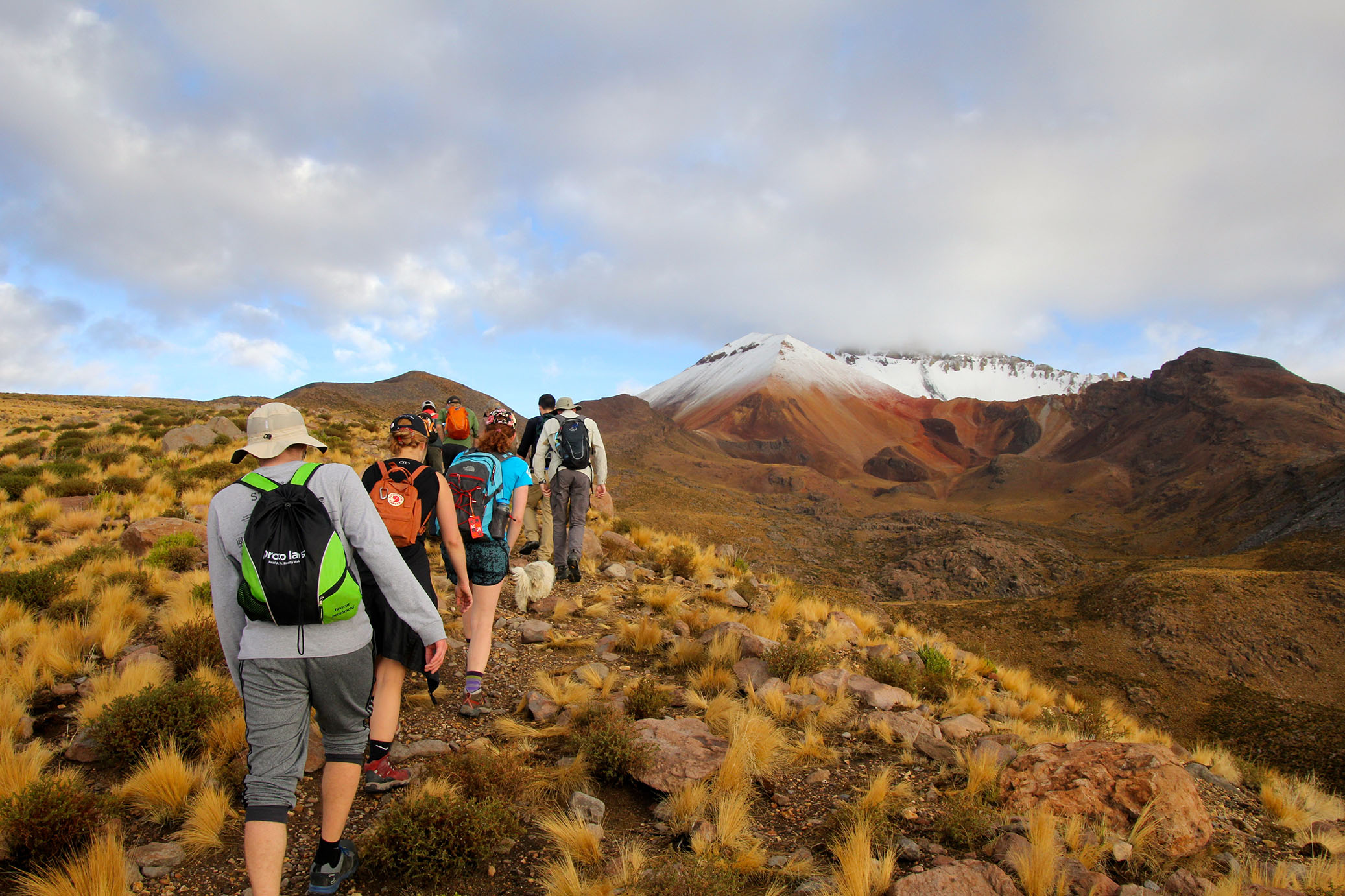17-01-15
We rose at 4:00am this morning to meet guides and see how far up the volcano we could get. Our hotel is in the town of Coqueza on the edge of the Salar de Uyuni, so one of the goals was to get up high enough to see the sunrise over the Salar. The Salar de Uyuni is the largest salt flat in the world, and in the wet season (now) it turns into a giant mirror when covered with water. So we were in for a treat.
We all strung out in a long line going up the old dirt road that leads to the parqueo (the parking lot), our headlamps picking out the rocky terrain beneath our feet. We had hoped to get a pickup truck up this road as it would cut an hour off of our hike and get us up higher faster, but were told the road was washed out too much for vehicles. At the level of the parqueo are a series of caves, one of which serves as a repository for pre-Incan mummies. The plan was to see these on the way back down the mountain. (It turned out that due to only one of our two guides having the key, and that guide hanging back with the last descenders, that only a few of us actually gained entrance to the mummy cave.)

On our way up toward the crater
Our large group somewhat naturally divided into two, with a faster group ambitious to reach the rusty-rocked crater up at 4900m if possible, and a slower group hoping to get as high as their physiology allowed. (I would point out that these groups did not fall into those in “good” shape and those not, as the body’s reaction to high elevation is independent of conditioning. We had runners and swimmers in both groups.) I ambitiously attached myself to the faster walkers, and was happy to have some leg strength built up by a few years of regular cycling to allow me to keep up. Surrounded by all these young athletes I was reminded (with a touch of ego) of JRR Tolkien’s description of Aragorn: All that is gold does not glitter, not all those who wander are lost, The old that is strong does not wither, deep roots are not reached by the frost. No Aragorn, I, but I managed to keep up with my 20-year olds, even though Sam at one point cracked admiringly about our guide (who was completely unfazed by the climb) “he must be 50 or 60!”
We maybe pushed harder than we should have, and I probably should have managed my participants more actively–asking that some turn back earlier to have everyone arrive back at the hotel around the same time, but everyone in the advance group made it up the 4 hour climb to where we could look down into the crater left by the last eruption years ago. At 4900 meters, this was about 15,900 ft, plenty high for our Minnesota bodies, and represented a climb of over 1000 meters from where we started. Suffice it to say we were very tired and breathing heavily by the time we arrived!
On our last legs of the climb we had seen Perry in the distance behind us, following the trail after her group had been abandoned by their guide (he later showed up again). I was cheering her on to catch up to us, but she wisely decided against the final stage and joined us on the descent.

At 4900m (about 16,000 ft), on the crater rim.
So Perry was part of the small group that did get to see the mummies. The second guide finally arrived with the key after helping down the stragglers (we waited 45 minutes or so sprawled in exhaustion in front of the locked door along with the little dog that had made it all the way up the mountain with us, often dashing on ahead or chasing birds as if the climb were nothing. The students dubbed him “Scout” for his habit of dashing ahead to check out the coming terrain). The mummies were interesting, but I don’t think much of the information we got from our guide was very accurate. He said they were pre-Incan (which I had heard before and believe to be true), putting them at close to 2000 years old, if not more. But he claimed the collection of 7 mummies in this cave was a royal family that died there in the cave when the volcano erupted. A prior guide had told me (when my wife and daughter made the trip in 2013) that these mummies had been collected from various caves in the area and put here for safe keeping. Rather than being found in the fetal position because they curled up that way in fear of the eruption (as our guide suggested), the museum in Oruro (which my family visited in 2013) clearly showed that the cultural practice was to sew the deceased into a canvas bag in this position, perhaps out of respect for the person’s afterlife. So we ended up with not the best guides, but got a great hike out of it.

The cat that followed us had no respect for antiquity
The Internet connection here in La Paz (I write this on the 16th) doesn’t seem to want to let me upload any pictures of this remarkable landscape, but I will do so if I get the chance. We arrived here late last night, to a city reeling for the first time with a drought so severe that our first hotel canceled on us because they had no water. Now we’re stuffed into the available rooms here at the Hostal Ecuador, with the hope of spreading out into more when they become available.